Abstract
Renewable energy communities (RECs) aim at achieving economic, environmental, and social benefits for members and for society. This paper presents a roadmap for the design, operation, and monitoring of renewable energy communities in Italy, fundamental to guide and orient any stakeholder involved in the decision-making process of a REC. The roadmap is inspired by the Deming Cycle, also known as Plan-Do-Check-Act, which provides a framework for continuous improvement and standardization of the procedures. To demonstrate the practical application of the roadmap, a real case study is presented for Italian energy communities, making full adoption of data derived from official databases and using a real urban district as a case study. The findings of phase I in the “do” stage of the roadmap indicate that the REC could lead to a decrease in carbon emissions of roughly 38% and could support 51 to 67 families through REC’s revenues, depending on the installed PV capacity. Furthermore, both physical self-consumption and virtual self-consumption schemes assist in the sustainable transition of the built environment, where consumers have a significant impact on the electrical markets. Therefore, these results validate the roadmap’s effectiveness in promoting an informed design and implementation of RECs while guiding energy, social, and political decisions.
1. Introduction
The European Directive 2001/2018, “Renewable Energy Directive Recast,” also known as RED II, introduced the concept of Renewable Energy Community (REC) into the energy markets, fostering the diffusion of decentralized and collaborative energy production and distribution among citizens [1]. The Directive also provides financial support for electricity production from renewable sources and self-consumption. The Directive considers RECs a way to achieve environmental, social, health, and economic benefits for the territory in which they will be constituted. Therefore, RECs serve as stimuli for the decarbonization of the energy (and, more specifically, electricity) market while providing indications for a sustainable growth of urban areas.
In Italy, the transposition process of the Directive 2018/2001 began with the Milleproroghe Decree 162/2019 [2], in particular article 42-bis, then converted with Law n. 8/2020 [3]. Other related implementing measures are contained in the resolution 727/2022/R/eel of the ARERA, the Italian Regulatory Authority for Energy, Networks and Environment [4] and in the Ministerial Decree of the 16 September 2020 of the MISE, Ministry of Enterprises, and Made in Italy [5].
Italian regulations refer to RECs as legal entities constituted by the voluntary and open participation of citizens, small/medium enterprises, and municipal authorities. To this regard and also due to the incentives from the PNRR, the National Recovery and Resilience Plan, there are increasing examples of RECs in small municipalities, where the role played by local authorities has been decisive to start the constitution and design process of RECs [6].
Members of the REC maintain their rights as consumers (such as the right to choose the electricity distributor) and may withdraw from the community at any time. Electricity can be self-consumed within the REC members, who should mandatorily be connected to the power grid under the same primary substation. From the technical viewpoint, there is no specification on the renewable sources to be chosen or on the technological system to be installed. It is, however, remarkable how the majority of already operating RECs in the Italian territory adopts photovoltaics (PV) panels. This can be explained by the advantages deriving from an already consolidated technology, with affordable costs, supported by incentives, and easily integrated in buildings. With respect to the sizing of PV, the Legislative Decree 199/2001 [7] sets a total power of up to 1 MW that can be owned by the REC. REC members may also own PV systems before the constitution process of the community, however, in this case, the participation acceptance is set to the 30% of the total installed power of the future REC [8].
Regarding the environmental, economic, and social benefits envisaged by the Directive 2018/2001, it may be stated that environmental reduction can be estimated by evaluating the amount of electrical demand satisfied from renewable sources; economic advantages derive from the valorisation of the electricity fed into the grid and of the electricity shared within the REC. Social impacts may be attained by promoting the inclusion of families with low income and in a condition of energy poverty. In Italy, this definition refers to families that encounter difficulties in sufficiently heating their houses and paying the energy bills, estimated to hover around the 14% [9].
The concepts of energy communities, energy sharing, and peer-to-peer connections paved the way for a prolific production of research and studies among the scientific community. Regarding the adopted approach, optimization models are the most widely diffused to design energy assets within RECs [10], organized self-consumption patterns [11], and distribution networks [12]. For instance, Stentati et al. [13] proposed an optimization model to compute the battery charging/discharging policies while setting points of flexible loads and controllable generators under the Italian incentive systems. PV and energy storages size are optimized in the work of Cielo et al. [14] using a multicriteria procedure. Similarly, Cosic et al. [15] elaborated a mixed-integer linear programming (MILP) model to evaluate energy flows of RECs with distributed PV and storage systems. A dedicated MILP to model energy storage systems was used by Jasiński et al. [16]; results show that batteries only partially minimize the amount of energy drawn from the power grid when fees related to the capacity market are applied. Other production technologies, such as boilers, heat pumps, photovoltaics, and thermal storages have been taken into consideration by Zatti et al. [17]. Differently, the work of Mucha-Kuś et al. [18] investigates how different co-operative strategies, implemented within the Energy Communities, can enhance the overall economic benefits. Beyond optimization techniques, genetic algorithms [19,20], simulations [21,22,23], agent-based models [24], and complex network theory [25] have been explored in literature for energy sharing modelling. Apart from design issues, other authors highlight the lack of energy management strategies to address the increased complexity arising from multiple distributed energy technologies [26,27] or refer to renewable sources’ integration [28], energy efficiency, or carbon reduction [29]. In this perspective, Mussadiq et al. [30] proposed a rule-based mechanism with a load-generation balancing objective. Monitoring and management techniques are also analysed by Lazdins and Mutule [31] using the existing net metering systems in Latvia. Likewise, Mutani et al. [32] presented a procedure for energy consumption and production monitoring of municipalities and companies. Ghiani et al. [33] elaborated a list of metrics for RECs’ performances evaluation in Italy, while REC interactions with the power grid are discussed in [34]. Other control approaches can be found in [35], where authors presented two algorithms aimed at solving the open-loop control problem. Similarly, Bianchi et al. [36] proposed a stochastic model predictive control aiming at reaching the maximum economic benefit for RECs.
Despite the various studies proposed by the scientific community, Lowitzsch et al. [37] highlighted the need for a structured and organized framework to help stakeholders involved into the implementation process of RECs. In this same direction, Zulianello et al. [38] discussed some open questions to orient development of RECs. In light of this need, this study aims at filling this gap by proposing a structure roadmap for REC design, implementation and operation. To this scope, a comparative study conducted among the aforementioned papers and reported in Table 1 highlight the scope and novelties of this research. As emerge from the cited literature, various techniques and approaches for REC modelling, management, and control have been proposed; still, as also other literature recommends, there is the need for a structured and organized framework to orient decision-makers. Indeed, albeit detailed models remain of utmost importance for RECs’ design and operation, high-level and easy-to-apply tools should be at the disposal of stakeholders. This is also the case of Italy, where red tape and difficulties arising from complex procedures and authorizations negatively impact on the RECs diffusion [39].

Table 1.
Comparative table to highlight research gaps and novelties.
Only within a holistic action plan, the mentioned quantitative tools can effectively guide the stakeholder during the decision-making processes, thus helping in choosing the best scenario among different alternatives. As can be seen in Table 1, a properly defined roadmap is lacking in the literature, especially with reference to the Italian regulations.
Under this premise, aspects related to how to constitute the REC, how to choose members, measure to what extent any participation can be beneficial for the entire community from the environmental, economic, and social perspective, and how energy performances can be monitored remain partially open. This paper aims to address these questions, by proposing structured procedures to orient inhabitants, energy system owners, public administrations, or small/medium enterprises. Differently from the previously cited literature, this research provides guidance to these stakeholders during all stages of the REC constitution process, bypassing the bias on the design and operational phases, usually the most studied within the scientific community. Indeed, the constitution of a REC depends on several factors, starting from normative and regulatory issues to technological and operational aspects. In addition, stakeholders’ decisions also impact on the constitution process of RECs. As an example, municipalities may promote the inclusion of public buildings, as well as encourage the participation of residents and small enterprises, or ensure support to families in energy poverty conditions. To this scope, a renewable energy community roadmap, clarifying goals and objectives of RECs, is here defined. The roadmap is beneficial for all members of the forthcoming REC, as it is able not only to visualize the steps around its constitution, but also to visualize the temporal occurrence of any step as well as practical duties and expected outcomes. In addition, it fosters the communication among REC members, and is useful to evaluate REC performance in terms of deviation from the targeted objectives, here declined in environmental, economic, and social targets. As a further detail, and a novelty in the field of RECs, the presented roadmap lies its foundation in the so-called Deming Cycle, known also as Plan-Do-Check-Act (PDCA), notably diffused to elaborate strategies into organizations and small/medium to big enterprises. The PDCA cycle permits the adoption of an aware approach to orient decisions, being it constituted by well-defined processes focusing on the achievement of the overall objective of enhancing any management and operation activity.
The remainder of the paper is structured as follows. Section 2 presents the roadmap for the constitution of a new REC in Italy, following the steps of the Deming Cycle (PDCA). In the same section, the mathematical formulation of the optimization model (MILP) for the maximization of the NPV for an Italian REC is introduced and six tailored KPIs are presented. After the description of the case study and of possible operating scenarios in Section 3, the results from the optimization are discussed in Section 4. Finally, Section 5 states how the most important outcomes of this work can help in filling the identified research gaps while providing limitations and future extensions of the study.
2. Materials and Methods
2.1. Renewable Energy Community Roadmap
A roadmap can be intended as a plan of informed steps to increase awareness on how successfully run a project and define long-term strategies. The roadmap itself can be specified through milestones, i.e., particular goals to be targeted to reach the final objective. From a general perspective, the main elements of a roadmap are:
- a goal, i.e., the final objective;
- activities, i.e., actions put in place by stakeholders to achieve intermediate targets;
- milestones, i.e., tangible outputs fundamental to achieve the goal;
- timeline, i.e., the temporal occurrence of activities.
The roadmap developed in this study takes inspiration from the Plan-Do-Check-Act scheme, a management structure intensively used to control processes or products and ensure their continuous improvement. According to this, the different steps of the roadmap, including milestones and intermediate activities, should be continuously monitored and revised. This allows for a dynamic roadmap, created to continuously support REC members and stakeholders. With reference to the Italian normative, the above-mentioned steps of the roadmap have been elaborated according to Figure 1. In the roadmap, a year has been identified as the temporal horizon. In this timeframe, the different activities take place in a sequential way. It is worth noting that, although specifically built to help members of future RECs in Italy, its grounding steps can be easily applied to other European countries.

Figure 1.
Elaborated roadmap for the constitution of RECs in Italy.
Step 1: PLAN
The first aspect to be considered is the identification of the local context in which the REC is planned to rise, starting with a study of the demographics as well as environmental, economic, and social drivers. In fact, RECs should not only target the environmental and economic conveniences, but also include the social attention to people living in slums or in a condition of energy poverty, as also suggested by the SDG7. Usually, there is always a member or a group of members taking the lead for this stage: in Italy, due also to the incentives dedicated to small/medium municipalities, it is common that local authorities or mayors seize the initiative and begin a consultation process for the engagement of citizens into the forthcoming REC. The starting point consists of the organization of dedicated meetings involving possible stakeholders, such as citizens associations, groups of consumers, retailers, and/or PV owners. The meetings have to set the basis for a common and shared vision of the REC: it is of utmost importance to gain awareness on the normative context as well as to focus on environmental concerns, expected economic revenues, and concrete actions to address energy poverty of residents. The milestone for this activity consists of a dissemination campaign, aiming at communicating to all citizens the advantages deriving from participating to a REC and raising awareness of the importance of single contributions for a sustainable transition. The subsequent step relies on the definition of a working plan to develop the strategy to be followed. The milestone for this last activity is the elaboration and writing of the call for participation that will be publicly diffused within the territory. From a temporal viewpoint, these activities may cover around two months.
Step 2: DO
Three main activities can be identified in this stage: the call for action, a development stage, and the effective REC constitution. The call for participation is made available through publication in the municipality website and through any official networks. The timeframe for participation can be arbitrarily set, but 3–4 weeks may be recommended. The publication of the call is the milestone for this activity. At the end of the call, the development phase I should (i) evaluate the geographical and technical potential of interested participants, who responded to the call, as well as verify the accomplishment of all normative aspects; and (ii) model the virtual and physical self-consumption rates among the future members of the REC. The two milestones for this activity are the energy mapping and the technical and operational design. The last activity in the “do” stage is the constitution of the REC, whose milestone consists of the juridical recognition from the GSE. The “do” stage is the most critical for an effective and reliable design of the community and is characterized by a higher duration, usually around 6 months.
A core activity in this stage consists of the identification of the electrical loads of the participants of the community. Energy audits may be conducted to determine energy profiles and critically identify which buildings consume the most and what energy efficiency measures could be applied to save costs and energy. The audit should also focus on possible variations in future energy needs, as well as energy efficiency improvements able to reduce the energy demand. In case of difficulties in pursuing energy audits, there are methods available in the literature able to derive hourly consumption profiles for typical households from a few aggregated measures [39,40,41]. Data on energy demands should then be coupled with the choice of the renewable-based systems most suited for the local area in which the REC will be constituted. It is worth noting that the selection of a renewable system is not only dependent on the geographical location, it is also determined by economic and policy barriers. PV systems are likely the most suitable candidate as renewable production system for Italian cities. Indeed, from a spatial perspective, cities are usually densely populated, and rooftop areas represent a significant amount of free space, in conjunction with the high solar potential and with the attractiveness of the investment, making the PV technology sufficiently mature and competitive. Stakeholders involved in the evaluation of the solar production potential of RECs may benefit from free data portals and solar maps, such as SolarGIS [42] or PVWatts Calculator [43]. Subsequently, the technological and economic viability of the REC should be analyzed. This includes the consideration of auxiliary systems (batteries), infrastructure and equipment, costs, feed-in tariff, and subsidies. The steps explained so far belong to the operational stage of the REC constitution. However, under development phase I, it is also fundamental to determine how the geographical, technical, and normative constraints can be translated into the modelling of energy interactions at the community level. To have a better understanding of how RECs operate according to the Italian normative, Figure 2 serves as reference.
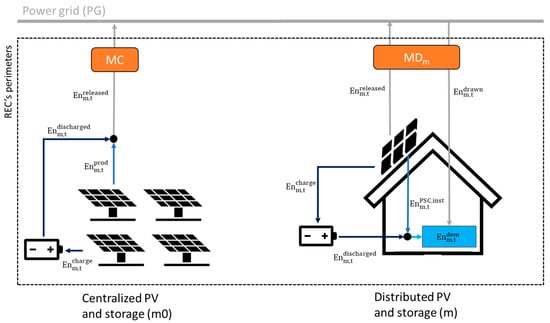
Figure 2.
Boundaries and interactions of REC members.
According to the centralized PV and storage configuration on the left, batteries are allowed to exchange electricity only with the power grid to which they are physically connected. Since the demand associated to this centralized member is always equal to zero, the only allowed distribution direction is outgoing, i.e., electricity is only released to the power grid and never drawn from it. The amount of electricity released to the power grid is recorded on an hourly basis by a centralized meter owned by the REC. This measurement will serve to compute the total electricity that is virtually shared among members by adding it to the electricity released by each member. This scheme is accounted for as virtual self-consumption, VSC, i.e., the condition for which electricity produced by the REC is virtually consumed by its members. For the distributed configuration, PVs and batteries are physically connected to the building; here the PV production is accounted for as physical self-consumed, a scheme called PSC by the normative. In addition, the PV system is connected to the power grid to release electricity in case of a surplus. In the distributed case, batteries are not allowed to exchange with the power grid. They can only be charged with electricity directly deriving from the PV discharged by electricity used by the building in which they are installed. In case of residual electrical demand, electricity is drawn from the power grid. For each distributed member, the meter measures released and drawn electricity.
The mathematical model serving for the development phase I is formulated with the aim of minimizing the Net Present Value, NPV, of the investment, as expressed in Equation (1):
The initial capital investment, , is equal to the sum of the capital costs for installing PVs and storages, considering the installed nominal capacity:
The yearly cash flow is given as the difference between revenues and maintenance and operating costs :
Revenues are equal to:
Maintenance and operating costs can be formulated as:
The following constraints refer to the electrical capacities and associated flows. Electrical production for each member of the REC can be formulated as:
with the following constraint on the minimum and maximum installed nominal capacity, regulated by the binary variable to control the installation of PVs for different members:
The amount of electricity physically self-consumed, according to the PSC scheme in the Italian normative, is equal to the minimum between the electricity produced by a production technology and the electrical demand, for each member of the REC and at each time-step , as can be seen in Equation (8).
For future explanations, it is important to clearly distinguish the two cases that can occur:
- → all demands have been covered by the PV production and an electrical energy surplus occurs.
- → only a part of the total demand has been covered by the PV production and, consequently, additional electrical supply is needed to satisfy the remaining demand.
As a further specification, along with the members of the REC, the model accounts for a “central node,” labelled as . The fictitious member is characterize by a nil demand, as expressed in Equation (9), and the PSC is consequently zero, as in Equation (10).
Equations (11) and (12) regulate the electricity balance at the single member level. These equations are strictly related to Equation (8) and two different cases may arise. In fact, in case (1), the left member of Equation (11) is equal to a positive electricity surplus that can either be used to charge the battery, , or released, i.e., sold, to the power grid, . Moreover, in this case, the left member of Equation (12) is equal to zero, forcing and to be zero as well. On the contrary, in case (2), the left members of Equations (11) and (12) are, respectively, equal to zero and to a positive value that represents the electricity deficit. The latter can be covered by the storage, , or by the power grid, . These equations hold also for the central node . In particular, they force all produced electricity to be released to the power grid.
Moving from the single member to the community level, the total released, , and drawn electricity, , are calculated with the following two equations.
It is worth noting that Equation (14) also includes the amount of electricity discharged by the centralized storage, eventually installed at the central node , to cover some excess demand of the community just before buying it from the power grid. The amount of electricity that is virtually shared under the VSC scheme at each time-step is computed as recommended by the Italian technical framework for RECs, Equation (15).
Finally, the exported and imported electricity represent the amount of electricity that is, respectively, released and drawn to and from the power grid net of the shared electricity. In particular, the latter is used to compute the actual emissions associated with the electricity production of the power grid.
This final part of the model presents all the equations related to the installation and operation of storage systems. Equation (18) controls whether a storage system is installed or not at a specific member while posing a limit on its maximum capacity.
The maximum charging and discharging electricity of all storage systems is limited by the energy to capacity ratio as in Equations (19) and (20).
The dynamic of the state of charge of storage systems is expressed by Equation (21), whilst Equation (22) is a time periodic constraint to plan the next period of storage. Equation (23) limits the minimum and maximum state of charge of the storage accounting for the depth of discharge, , and depth of discharge, , that can be found in the data sheet of each battery.
Finally, when a storage system is installed, the PSC of each distributed member is given by the sum of electricity coming from the PV and from the storage physically connected to the member, as expressed in Equation (24). As before, the PSC of the central node is equal to zero, as expressed in Equation (25). In fact, even though electrical exchanges may occur within the community and with the power grid, no exchanges occur between the grid and any of the distributed storages installed in the REC.
2.2. Linearization Technique
At the moment, Equations (8) and (15) are non-linear relationships, thus adding nonconvexity to the model and making it a Mixed-Integer Non-linear Programming (MINLP) problem. To linearize these equations, piece-wise linear functions can be used [44]. This can be done by introducing a new set of binary variables, , , , and , reported from Equations (26)–(30).
Similarly, Equation (15) is linearized using the binary variables defined from Equations (31)–(34).
Step 3: CHECK
This stage consists of the development phase II, focused on the definition of benchmarks to which the REC performances should be compared during the monitoring activity. As an added-value, these tailored metrics also help for cross-comparison to other RECs, or to evaluate the impact of new members. This step usually has a duration of around 3 months. The definition of REC makes it evident that the primary goal is to attain community benefits in economic, environmental, or social aspects. Two commonly used load matching indicators are the self-consumption ratio and the self-sufficiency ratio , addressing technical and energetic aspects. More in detail, these indicators may evaluate how well distributed production and demand are matched in time and magnitude. indicates the amount of produced electricity that is self-consumed by all members, whereas measures whether the REC’s needs are met by the production of PV panels, as expressed in Equations (35) and (36). may also be interpreted as the degree of independence from the power grid. It is worth noting that the complementary to one gives information about the amount of electricity released to the power grid, thus sold at the unit electricity price of the market. For the VSC scheme, the virtual self-sufficiency ratio is defined in Equation (37); it measures the shared electricity over the total demand. Therefore, this indicator highlights to what extent the REC production is sufficient to meet the electrical needs of members under the VSC scheme, i.e., for the amount of electricity valorized and incentivized according to the Italian normative. The indicator , called total self-consumption ratio, is built as a combination of the indicators and , as reported in Equation (38). It measures to what extent the REC satisfies the electrical demand with instant PSC. These differentiations are also helpful to evaluate the economic impact for REC members in relation to the total consumption. Indeed, under the definition of the normative, PSC can be considered as an avoided expense, VSC as revenues, as it is incentivized.
Environmental performances are evaluated considering the carbon dioxide emission index, , calculated as the percentage of CO2 emissions avoided thanks to the constitution of the REC, as expressed in Equation (39). In fact, when a REC is constituted, the electricity produced by renewable technologies and discharged by batteries reduces the amount of electricity imported from the grid, . In this paper, a net-balancing approach to carbon dioxide emissions is chosen, and, therefore, electricity sharing under the VSC scheme is considered carbon-neutral. A national-specific standard emission factor is associated with the electricity imported from the grid and used to calculate grid-related emissions, as in Equation (40).
To account for the social impact of the REC, the energy poverty help index is calculated to account for the number of families in energy poverty conditions that can be financially helped thanks to the distribution of REC revenues. Therefore, the indicator can be calculated as in Equation (41). The value of AED has been fixed equal to , that is the reference for a typical Italian family according to the Italian National Institute of Statistics [45].
Step 4: ACT
The fourth step of the roadmap consists of a review of the technical and juridical design of RECs. During this activity, actions may be taken with respect to the results obtained from the previous steps and, generally, from the experiences gained during the overall constitution process. Indeed, it is important to review the core activities of the other steps and identify eventual “bottlenecks” or criticisms to adjust the strategy trajectory and incorporate any lessons learned. In case any change is going to be adopted (such as new documents, model adjustments, or the introduction of new indicators), the PDCA cycle should start again and be revised according to the needs. A typical milestone of this step is the standardization of procedures, fundamental to guarantee the continuous improvement and operation of the REC and also to serve as example for other forthcoming RECs. The timeframe for this step is around 1 to 2 months.
3. Case Study
The steps of the REC roadmap have been applied to a real urban area of 17 residential (multiapartment) buildings in Catania, Sicily, once verified that all candidate members respect the criteria established by the Italian regulation [8]. For each building, Table 2 reports the data that have been obtained through a collection campaign carried out by the authors in the year 2022. After the building Id, the columns show in order: the available south-oriented roof surface, the maximum PV and storage capacities, and the annual electricity consumption for each building. Values in the third and fourth columns are used as input data of the optimization to define the upper bounds on the total nominal capacity of PVs and batteries that can be installed for each building, see Equations (7) and (18). The annual electricity consumption, in the last column, represents the total electrical energy demand derived from the collection campaign.

Table 2.
Electrical demands and maximum capacities for PV and battery systems of each participant of the REC for the year 2022.
The maximum installable PV capacity, reported in the third column, is related to the total available rooftop area of each building. In fact, it has been calculated by multiplying the available area, in the second column, by a typical factor of 10 m2/kWn that represents the occupied surface of a PV panel of 1 kW of nominal capacity, as done in Ref. [46]. Along with the buildings of the future REC, the model includes a dedicated area suitable for PV installation and indicated with the label . Therefore, it has null electrical demand. The PV installation of this site is accounted to be owned by the future REC, and the balances between production and electricity consumed by the REC or sold to the power grid are managed according to the VSC scheme on an hourly basis. The maximum capacity of the battery, reported in the fourth column, is calculated considering the PV maximum capacity.
The same load scaling technique used in the research of Ref. [40] has been applied in this study to derive the hourly electrical demand profile starting from aggregated annual electricity demands and associating a typical daily electrical load curve for residential buildings, plotted in Figure 3.
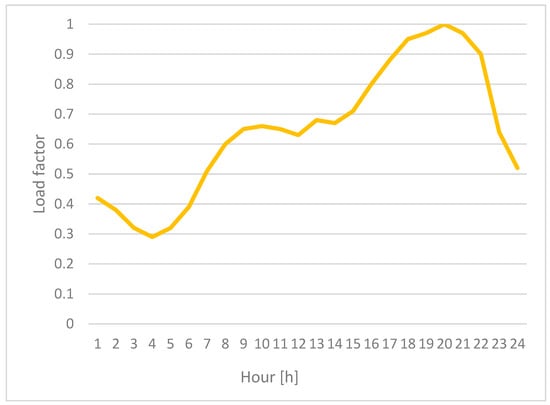
Figure 3.
Typical daily load curve for a residential apartment.
Two typical electrical demand profiles derived from the load scaling technique in the first day of the year have been reported in Figure 4 and Figure 5, for building m1 and building m15, the less and most energy intensive of the future REC, respectively.
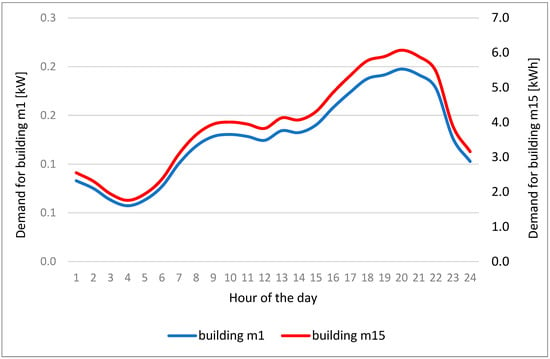
Figure 4.
Electrical demand profile of building m1 and m15.
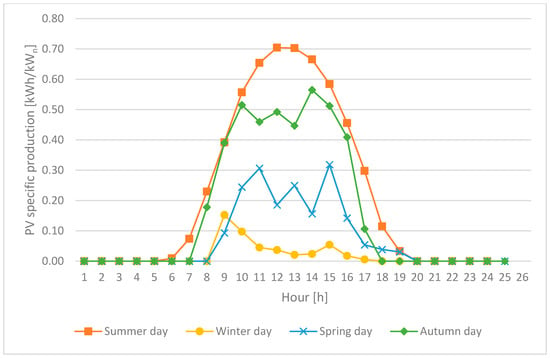
Figure 5.
Hourly specific production profile per installed kWn of PV for four typical days (summer day, 21 June 2022; winter day, 21 December 2022; spring day, 20 March 2022; autumn day, 23 September 2022) in the Nesima district (Catania).
The hourly electrical production from PV panels has been estimated using PVWatts Calculator [43]. Figure 5 reports the PV production per of installed capacity for a spring, summer, autumn, and winter typical days in the Nesima district (Catania). The optimization model derives the total hourly electrical production of each building during the entire year by multiplying the values of the PV production per of installed capacity and the variable , i.e., the nominal capacity of PV panels installed on buildings’ rooftop areas.
The technical and economic parameters used to run the model are listed in Table 3. It is worth noting that the unit cost of electricity purchased from the power grid as well as the unit price of selling electricity to the energy market, as defined from the GSE [47], are here not included, but are used to perform the following scenario analysis.

Table 3.
Technical and economic parameters.
The optimization model is used to run different scenarios, identified in Figure 6, all with the same objective function, i.e., the maximization of the NPV. Two main scenarios have been chosen: a first scenario #1, is optimized using the input data listed in Table 2 and Table 3 and a second scenario #2 with an increased installed capacity on the centralized node , from 50 to 100 . The node m0 has been chosen as the sole site in which the PV installation may be varied; indeed, buildings’ rooftops are already limited by their area and PV capacity cannot be varied arbitrarily. Under the base scenario #1, four different variations in terms of both unit cost of purchasing electricity from the power grid and unit price of selling electricity to the power grid have been selected. A minimum and maximum variation of 25% has been accounted for, as can be observed from Figure 6. The scenarios are labelled as #1.1 (+25% increment of unit cost of purchasing electricity from the power grid), #1.2 (−25% decrement of unit cost of purchasing electricity from the power grid), #1.3 (+25% increment of unit price of selling electricity to the power grid), and #1.4 (−25% decrement of unit price of selling electricity to the power grid). This choice is useful to evaluate to what extent the unit cost and unit price impact on the REC performances and on the NPV, which is highly influenced by these variables.

Figure 6.
Scenarios used for optimization.
The unit cost of buying electricity from the power grid is 0.53 [51] and the unit price of selling electricity to the energy market is 0.435 [51].
4. Results and Discussion
The results of the optimized scenarios described in Figure 6 are presented and discussed here. As can be seen from Table 3, the total electrical demand of the REC is equal to 321,714.5 kWh/y. Without the constitution of the REC, the total cost for purchasing electricity from the power grid would have been €170,520 (considering the unit cost of 0.53 [51]). In addition to this, if considering the investment for PV panels for all buildings, the NPV over a temporal horizon of 20 years would be −€2,317,422.25. These considerations are useful to discuss the economic impact of the REC. The optimized capacities of PV and storages are summarized in Table 4, for both scenarios #1 and #2.

Table 4.
Optimized values for PV and storage installations for scenarios #1 and #2.
The NPV is negative for both scenarios, still it is higher than the prospective value of the NPV without REC, as discussed above, i.e., in the case of purchasing all the electricity from the power grid to satisfy the demands of the buildings, without the chance of self-consumption or sharing. In these terms, the advantage of constituting a REC is evident. Moreover, the NPV of scenario #2 is higher than scenario #1, as the installed PV capacity on building positively impacts on the cash flow despite the higher initial investment. As can be observed, no batteries have been installed. Indeed, under the Italian regulation, the installation of batteries would not have been advantageous in terms of NPV maximization, considering that the electricity would be stored instead of sold to the power grid at a price that would be in any case higher than the price at which electricity would be shared among members [4]. Indeed, with battery installation, the shared electricity increases and, consequently, the sold electricity to the power grid decreases. As a further aspect, the initial investment of batteries should also be considered in the overall maximization of the NPV, therefore the overall income significantly diminishes in the case of batteries. Regarding the installed PV capacity, it can be observed that it corresponds to the maximum permitted values, thus confirming that, under the VSC, PV installation is convenient, despite the still significant initial investment. The CO2 emissions have been calculated by associating the net imported electricity from the power grid, , and the national emission factor of 0.247 kgCO2/kWh [51]. As expected, some indicators do not vary when moving from scenario #1 to scenario #2, i.e., and . In fact, the increase of centralized PV capacity does not affect the total PSC and all the electricity produced from the central node is released to the power grid and affects the sole VSC. As expected, the self-consumption ratio, , remains unchanged moving from scenario #1 to scenario #2. Increasing the centralized PV capacity has no impact on the total PSC, as the electricity produced from released to the power grid and only affects VSC, as confirmed by the increase of the indicator . In addition to that, the increases, as it associated with imported electricity from the grid that changes with the amount of electricity shared, as in Equation (17). The NPV is positively affected as the increased electricity production is sold to the grid and also shared among REC members. On the contrary, increasing the PV capacity at the central node decreases the indicator , therefore showing a minor contribution in terms of PSC. The can also be discussed in relation to , reflecting the shared electricity over the total demand. Comparing these two indicators is equivalent to comparing the two main contributors to NPV: electricity savings from PSC, in the case of , and incentives for shared electricity, in the case of . Of course, the total self-consumption rate , as the sum of and , represents the total amount of electricity consumed under both physical and virtual schemes, thus serving as an overall performance metric of the REC, useful for monitoring, benchmarking, and more importantly, evaluating the efficacy of actions taken with the goal of continuously improving the system. Finally, the social index of energy poverty and household income increases when transitioning from scenario #1 to scenario #2, indicating that a higher economic contribution can be provided to families suffering from energy poverty within the REC’s area of influence.
Going into more detail about the electricity interactions within the REC and between the REC and the power grid, it is necessary to highlight the daily exchanges under scenario #1; indeed, the variation from scenario #2 is only attributed to the VSC and, in any case, comparable with the following results. In particular, the electricity fluxes are shown at the community level and for single buildings. Starting with the community level, Figure 7 reports the daily electricity production that is released to the power grid.

Figure 7.
Daily electricity production released to the power grid in 2022 and scenario #1.
The exchanges at the community level have to be considered as net to PSC. In other words, during each day, the electricity exchanges accounted for in Figure 7 only regards the physical self-consumption and the electricity shared within the REC is accounted for as in the VSC scheme. As can be observed, a higher amount of electricity production released to the grid can be noticed during the spring and summer seasons, due to the higher production from PV panels. On the contrary, during winter days, the minor PV production coupled with the PSC from members yields a lower net amount of electricity that is released to the power grid. As a comparison, Figure 8 plots the daily electricity that is drawn from the power grid at the community level.
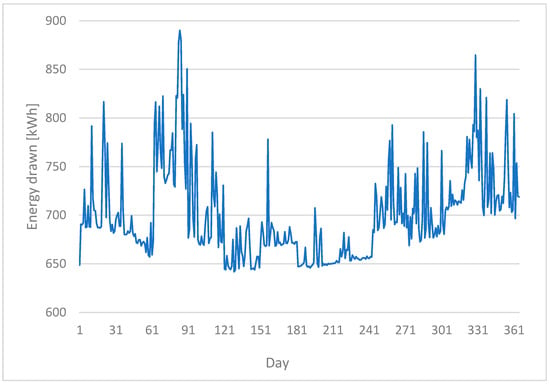
Figure 8.
Daily electricity drawn from the power grid in 2022 and scenario #1.
It corresponds to the electricity required to fulfill the demands of the REC members that have not been satisfied with the PV production. At the same time, it is also important to discuss the electricity shared within the REC under the VSC scheme, reported in Figure 9.
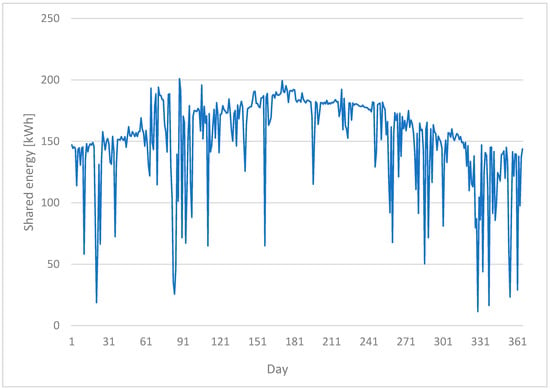
Figure 9.
Daily electricity virtually shared within the REC in 2022 and scenario #1.
The electricity exchanges plotted in Figure 9 correspond to Equation (15) and constitute the interactions occurring within the REC. The electricity that is produced by PV panels and is not consumed under the PSC scheme constitutes the electricity released to the grid, as said when Figure 8 was commented on. The electricity released to the grid, however, also includes the contributions of the VSC, which corresponds to the electricity shared among members of the REC. As can be observed, the amount of shared electricity is higher during summer, when the production from PV is higher. In addition to this, it is worth noting that the electricity fluxes plotted in Figure 9 are incentivized from the normative, as they are identified as VSC within the REC. Therefore, the higher this amount of electricity shared among members is, the better in terms of revenues for the community.
Figure 10 plots the electricity imported and exported from the REC during the entire year.
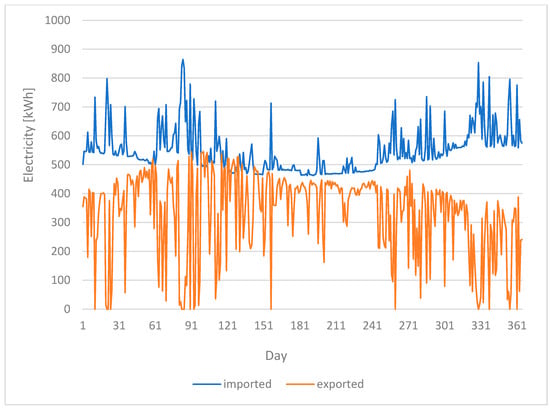
Figure 10.
Daily exported and imported electricity in 2022 and scenario #1.
These fluxes should be read as the electricity exported and net imported electricity shared among members. In this regard, the electricity exported to the power grid is paid but not valorized under the VSC scheme, as it not shared among members. The imported electricity, on the other side, is also responsible for the CO2 emissions that are associated with the REC.
Finally, to properly account for a correct design of the electricity fluxes useful to conclude the development phase I of the “do” stage of the roadmap, it is crucial to evaluate the exchanges at the level of single buildings. For this scope, the less and most energy intensive buildings were chosen, i.e., building m1 and building m15, whose optimized results are reported in Figure 11 and Figure 12, respectively.
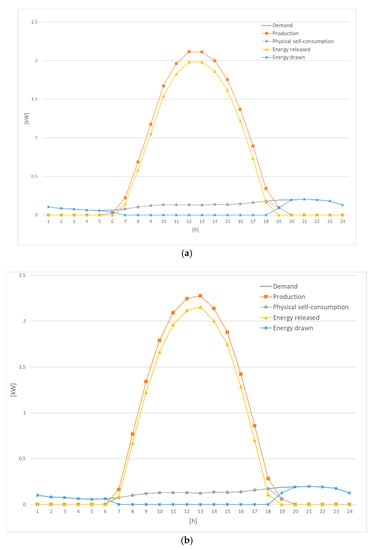
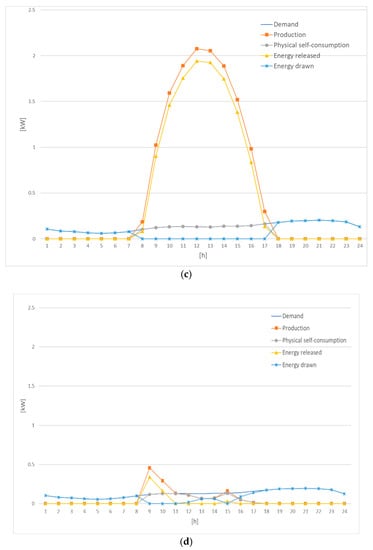
Figure 11.
Electricity flows for building m1 during a typical (a) spring day (20 March 2022), (b) summer day (21 June 2022), (c) autumn day (23 September 2022), and (d) winter day (21 December 2022), for scenario #1.
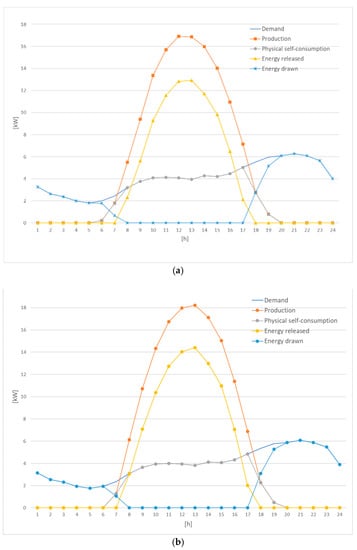
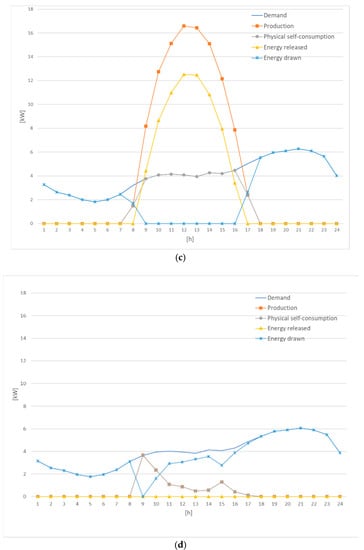
Figure 12.
Electricity flows for building m15 during a typical (a) spring day (20 March 2022), (b) summer day (21 June 2022), (c) autumn day (23 September 2022), and (d) winter day (21 December 2022), for scenario #1.
As can be observed in Figure 11, for all the selected typical seasonal days, the production from PV is only partially used to cover the demand of the members themselves, and the higher contribution in terms of PV production is then released to the grid. This amount accounts for VSC, i.e., for the electricity sharing among members (and, therefore, for electricity that will be valorized from the GSE), and also for the electricity that will be sold to the power grid (and, therefore, simply paid in line with the unit price recognized from the electricity markets). These trends are common for all the four seasonal days, but with variations deriving from different PV production in summer, winter, and spring/autumn.
Figure 12 reports the same information shown in Figure 11, but for building m15, the REC member with the higher electricity demand.
Here, as can be noticed, the amount of electricity consumed under the PSC scheme is higher, due to the higher electricity demand of the building.
The optimized results for the scenarios #1.X, i.e., the scenarios in which there is variation of the unit cost of purchasing electricity from the grid (#1.1 and #1.2) or selling electricity to the power grid (#1.3 and #1.4) are reported in Table 5.

Table 5.
Optimized results for scenarios #1.X.
By comparing these scenarios with the base scenario #1, a change in the NPV is observed. In addition, this variation depends more significantly on the unit cost of purchasing electricity to the power grid (58%) than the unit price of selling electricity to the grid (a variation of 36%). Therefore, the purchase from the grid has a more evident impact on the NPV (negatively and positively).
5. Conclusions
This study presented a roadmap for the design, operation, and monitoring of RECs in Italy. The roadmap is inspired by the Deming Cycle, also known as Plan-Do-Check-Act, and consists of four main stages: Planning, Implementation, Monitoring, and Evaluation. The results of the case study in Sicily and the monitoring stage show how the design of electrical interactions among members of the RECs, as well as interactions between each member and the power grid, is essential to evaluate the revenues, establish to what extent the REC contributes to the reduction of carbon emissions, and determine their social impact calculated in terms of concrete assistance for families under energy poverty conditions. The results of the development phase I as part of the “do” stage reveal that the REC could contribute to a reduction of around 38% of the carbon emissions with 51 to 67 families helped through the revenues of the RECs, depending on the installed PV capacity. In addition, the electricity self-consumed under the PSC scheme and the electricity shared under the VSC scheme among members of the REC facilitate a sustainable transition, in which consumers substantially impact the electrical markets. Therefore, by following the roadmap, communities can contribute to a sustainable transition, reduce emissions, and help families in conditions of energy poverty.
Further improvements of the proposed research could be attained by including uncertainties related to the cost of electricity from the power grid and to the hourly demand of REC´s members. Secondly, while the model is built to cover the electrical demand, it does not consider the thermal consumption of buildings. In this direction, thermal sharing could represent a way to extend this study, for instance, via a district heating system. Future development could be devoted to evaluating the impact of new members in an already constituted and operating REC. Finally, implementing more comprehensive and tailored control and monitoring procedures could positively affect the final stage that deals with continuous improvement of the REC.
Author Contributions
Conceptualization, A.F. and R.V.; Methodology, E.C., A.F. and R.V.; Software, E.C.; Formal analysis, R.V.; Investigation, E.C. and R.V.; Resources, E.C.; Data curation, E.C. and R.V.; Writing—original draft, E.C. and R.V.; Supervision, A.F. All authors have read and agreed to the published version of the manuscript.
Funding
This research has been financially supported by “Piano di incentivi per la ricerca di Ateneo 2020/2022 (Pia.ce.ri.)—Linea 2D”—University of Catania and by the SIS-RENEW research project (Piano di incentivi per la Ricerca 2020–2022).
Data Availability Statement
The data presented in this study are available on request from the corresponding author.
Conflicts of Interest
The authors declare no conflict of interest.
Nomenclature
| Indices and sets | |
| Member of the REC | |
| Time-step | |
| Year | |
| Subsets | |
| Distributed members | |
| Time-step for storage | |
| Parameters | |
| Unit investment cost for storage | |
| AED | Annual energy demand [kWh/y] |
| Continuous variables | |
| Binary variables | |
| , | |
| , | |
References
- Directive (EU) 2018/2001 of the European Parliament and of the Council on the Promotion of the Use of Energy from Renewable Sources. Off. J. Eur. Union 2018, OJ L 328, 82–209.
- Decreto Milleproroghe 2019, Legislative Decree 162/19, Article 42-bis. Available online: https://www.gazzettaufficiale.it/eli/id/2020/02/29/20A01353/sg (accessed on 1 March 2023).
- Law 8/2020, Italian Official Gazette on 29 February 2020. Available online: https://www.gazzettaufficiale.it/eli/id/2020/02/29/20G00021/sg (accessed on 1 March 2023).
- Delibera 27 December 2022, 727/2022/R/eel 328727, ARERA. Available online: https://www.arera.it/it/docs/22/727-22.htm (accessed on 1 March 2023).
- Ministerial Decree of the 16 September 2020, Official Gazette of the Italian Republic. Available online: https://www.gazzettaufficiale.it/eli/id/2020/11/16/20A06224/sg (accessed on 1 March 2023).
- Italian Recovery and Resilience Plan (PNRR). Available online: https://www.italiadomani.gov.it/it/home.html (accessed on 1 March 2023).
- Legislative Decree 199/2021, Official Gazette of the Italian Republic. Available online: https://www.gazzettaufficiale.it/eli/id/2021/11/30/21G00214/sg (accessed on 1 March 2023).
- GSE, Regole tecniche per l’accesso al servizio di valorizzazione e incentivazione dell’energia elettrica condivisa, 4 April 2022. Available online: https://www.gse.it/documenti_site/Documenti%20GSE/Servizi%20per%20te/AUTOCONSUMO/Gruppi%20di%20autoconsumatori%20e%20comunita%20di%20energia%20rinnovabile/Regole%20e%20procedure/Regole%20Tecniche%20per%20accesso%20al%20servizio%20di%20valorizzazione%20e%20incentivazione%20energia%20elettrica%20condivisa.pdf (accessed on 1 March 2023).
- Istituto Nazionale di Statistica (ISTAT). Available online: https://www.istat.it/en/archivio/poverty (accessed on 1 March 2023).
- Cruz-De-Jesús, E.; Martínez-Ramos, J.L.; Marano-Marcolini, A. Optimal Scheduling of Controllable Resources in Energy Communities: An Overview of the Optimization Approaches. Energies 2022, 16, 101. [Google Scholar] [CrossRef]
- Fichera, A.; Volpe, R.; Frasca, M. Assessment of the Energy Distribution in Urban Areas by Using the Framework of Complex Network Theory. Int. J. Heat Technol. 2016, 34, S430–S434. [Google Scholar] [CrossRef]
- Fichera, A.; Frasca, M.; Volpe, R. On Energy Distribution in Cities: A Model Based on Complex Networks. Int. J. Heat Technol. 2016, 34, 611–615. [Google Scholar] [CrossRef]
- Stentati, M.; Paoletti, S.; Vicino, A. Optimization of energy communities in the Italian incentive system. In Proceedings of the 2022 IEEE PES Innovative Smart Grid Technologies Conference Europe (ISGT-Europe), Novi Sad, Serbia, 10–12 October 2022; pp. 1–5. [Google Scholar] [CrossRef]
- Cielo, A.; Margiaria, P.; Lazzeroni, P.; Mariuzzo, I.; Repetto, M. Renewable Energy Communities business models under the 2020 Italian regulation. J. Clean. Prod. 2021, 316, 128217. [Google Scholar] [CrossRef]
- Cosic, A.; Stadler, M.; Mansoor, M.; Zellinger, M. Mixed-integer linear programming based optimization strategies for renewable energy communities. Energy 2021, 237, 121559. [Google Scholar] [CrossRef]
- Jasiński, J.; Kozakiewicz, M.; Sołtysik, M. The Effectiveness of Energy Cooperatives Operating on the Capacity Market. Energies 2021, 14, 3226. [Google Scholar] [CrossRef]
- Zatti, M.; Moncecchi, M.; Gabba, M.; Chiesa, A.; Bovera, F.; Merlo, M. Energy Communities Design Optimization in the Italian Framework. Appl. Sci. 2021, 11, 5218. [Google Scholar] [CrossRef]
- Mucha-Kuś, K.; Sołtysik, M.; Zamasz, K.; Szczepańska-Woszczyna, K. Coopetitive Nature of Energy Communities—The Energy Transition Context. Energies 2021, 14, 931. [Google Scholar] [CrossRef]
- Moncecchi, M.; Meneghello, S.; Merlo, M. Energy Sharing in Renewable Energy Communities: The Italian Case. In Proceedings of the 2020 55th International Universities Power Engineering Conference (UPEC), Turin, Italy, 1–4 September 2020; pp. 1–6. [Google Scholar] [CrossRef]
- Moncecchi, M.; Meneghello, S.; Merlo, M. A Game Theoretic Approach for Energy Sharing in the Italian Renewable Energy Communities. Appl. Sci. 2020, 10, 8166. [Google Scholar] [CrossRef]
- Viti, S.; Lanzini, A.; Minuto, F.D.; Caldera, M.; Borchiellini, R. Techno-economic comparison of buildings acting as Single-Self Consumers or as energy community through multiple economic scenarios. Sustain. Cities Soc. 2020, 61, 102342. [Google Scholar] [CrossRef]
- Trevisan, R.; Ghiani, E.; Ruggeri, S.; Mocci, S.; Pisano, G.; Pilo, F. Optimal sizing of PV and Storage for a Port Renewable Energy Community. In Proceedings of the 2022 2nd International Conference on Energy Transition in the Mediterranean Area (SyNERGY MED), Thessaloniki, Greece, 17–19 October 2022; pp. 1–5. [Google Scholar] [CrossRef]
- Jasiński, J.; Kozakiewicz, M.; Sołtysik, M. Determinants of Energy Cooperatives’ Development in Rural Areas—Evidence from Poland. Energies 2021, 14, 319. [Google Scholar] [CrossRef]
- Fichera, A.; Pluchino, A.; Volpe, R. Modelling energy distribution in residential areas: A case study including energy storage systems in catania, Southern Italy. Energies 2020, 13, 3715. [Google Scholar] [CrossRef]
- Fichera, A.; Fortuna, L.; Frasca, M.; Volpe, R. Integration of complex networks for urban energy mapping. Int. J. Heat Technol. 2015, 33, 181–184. [Google Scholar] [CrossRef]
- Aranzabal, I.; Gomez-Cornejo, J.; López, I.; Zubiria, A.; Mazón, J.; Feijoo-Arostegui, A.; Gaztañaga, H. Optimal Management of an Energy Community with PV and Battery-Energy-Storage Systems. Energies 2023, 16, 789. [Google Scholar] [CrossRef]
- Bachar, R.K.; Bhuniya, S.; Ghosh, S.K.; Sarkar, B. Controllable Energy Consumption in a Sustainable Smart Manufacturing Model Considering Superior Service, Flexible Demand, and Partial Outsourcing. Mathematics 2022, 10, 4517. [Google Scholar] [CrossRef]
- Guchhait, R.; Sarkar, B. Increasing Growth of Renewable Energy: A State of Art. Energies 2023, 16, 2665. [Google Scholar] [CrossRef]
- Mishra, M.; Ghosh, S.K.; Sarkar, B. Maintaining energy efficiencies and reducing carbon emissions under a sustainable supply chain management. AIMS Environ. Sci. 2022, 9, 603–635. [Google Scholar] [CrossRef]
- Mussadiq, U.; Ahmed, S.; Sajid, M.; Elkamchouch, D.H.; Hussain, L.; Gaddah, A.; Al-Wesabi, F.N.; Hilal, A.M. The intelligent modelling and optimization of an economic and ecosystem-friendly model for grid connected prosumer community. PLoS ONE 2023, 18, e0276510. [Google Scholar] [CrossRef]
- Lazdins, R.; Mutule, A. Scenario simulation of a small-scale energy community management. In Proceedings of the 2022 IEEE 63th International Scientific Conference on Power and Electrical Engineering of Riga Technical University (RTUCON), Riga, Latvia, 10–12 October 2022; pp. 1–5. [Google Scholar] [CrossRef]
- Mutani, G.; Todeschi, V.; Tartaglia, A.; Nuvoli, G. Energy Communities in Piedmont Region (IT). The case study in Pinerolo territory. In Proceedings of the 2018 IEEE International Telecommunications Energy Conference (INTELEC), Turino, Italy, 7–11 October 2018; pp. 1–8. [Google Scholar] [CrossRef]
- Ghiani, E.; Trevisan, R.; Rosetti, G.L.; Olivero, S.; Barbero, L. Energetic and Economic Performances of the Energy Community of Magliano Alpi after One Year of Piloting. Energies 2022, 15, 7439. [Google Scholar] [CrossRef]
- Di Silvestre, M.L.; Ippolito, M.G.; Sanseverino, E.R.; Sciumè, G.; Vasile, A. Energy self-consumers and renewable energy communities in Italy: New actors of the electric power systems. Renew. Sustain. Energy Rev. 2021, 151, 111565. [Google Scholar] [CrossRef]
- Aittahar, S.; de Villena, M.M.; Derval, G.; Castronovo, M.; Boukas, I.; Gemine, Q.; Ernst, D. Optimal control of renewable energy communities with controllable assets. Front. Energy Res. 2023, 11, 21. [Google Scholar] [CrossRef]
- Bianchi, F.; Bosio, B.; Conte, F.; Massucco, S.; Mosaico, G.; Natrella, G.; Saviozzi, M. Modelling and optimal management of renewable energy communities using reversible solid oxide cells. Appl. Energy 2023, 334, 120657. [Google Scholar] [CrossRef]
- Lowitzsch, J.; Hoicka, C.E.; van Tulder, F.J. Renewable energy communities under the 2019 European Clean Energy Package—Governance model for the energy clusters of the future? Renew. Sustain. Energy Rev. 2020, 122, 109489. [Google Scholar] [CrossRef]
- Zulianello, M.; Angelucci, V.; Moneta, D. Energy Community and Collective Self Consumption in Italy. In Proceedings of the 2020 55th International Universities Power Engineering Conference (UPEC), Turin, Italy, 1–4 September 2020; pp. 1–5. [Google Scholar] [CrossRef]
- Lazzeroni, P.; Mariuzzo, I.; Quercio, M.; Repetto, M. Economic, Energy, and Environmental Analysis of PV with Battery Storage for Italian Households. Electronics 2021, 10, 146. [Google Scholar] [CrossRef]
- Lazzeroni, P.; Olivero, S.; Repetto, M. Economic perspective for PV under new Italian regulatory framework. Renew. Sustain. Energy Rev. 2017, 71, 283–295. [Google Scholar] [CrossRef]
- Lazzeroni, P.; Olivero, S.; FStirano Repetto, M. Impact of PV penetration in a distribution grid: A Middle-East study case. In Proceedings of the 2015 IEEE 1st International Forum on Research and Technologies for Society and Industry Leveraging a Better Tomorrow (RTSI), Turin, Italy, 16–18 September 2015; pp. 353–358. [Google Scholar] [CrossRef]
- Solar Irradiance Data (SolarGIS). Available online: https://solargis.com/ (accessed on 1 March 2023).
- NREL’s PVWatts Calculator. Available online: https://pvwatts.nrel.gov/ (accessed on 1 March 2023).
- Asghari, M.; Fathollahi-Fard, A.M.; Al-E-Hashem, S.M.J.M.; Dulebenets, M.A. Transformation and Linearization Techniques in Optimization: A State-of-the-Art Survey. Mathematics 2022, 10, 283. [Google Scholar] [CrossRef]
- Italian National Institute of Statistics (ISTAT). Available online: https://www.istat.it/ (accessed on 1 March 2023).
- Cutore, E.; Volpe, R.; Sgroi, R.; Fichera, A. Energy management and sustainability assessment of renewable energy communities: The Italian context. Energy Convers. Manag. 2023, 278, 116713. [Google Scholar] [CrossRef]
- GSE, Servizio Di Ritiro Dedicato. Available online: https://www.gse.it/servizi-per-te/fotovoltaico/ritiro-dedicato/come-accedere (accessed on 1 March 2023).
- GSE, Energy Communities Simulator. Available online: https://www.autoconsumo.gse.it/simulatore/input-base (accessed on 1 March 2023).
- Datasheet, Punto Energia Italia. Available online: https://www.puntoenergiashop.it/it/batterie/batterie-al-litio/weco/ (accessed on 1 March 2023).
- European Environment Agency (EEA). Available online: https://www.eea.europa.eu/ims/greenhouse-gas-emission-intensity-of-1 (accessed on 1 March 2023).
- Italy Electricity Prices, ARERA. Available online: https://www.arera.it/it/dati/eep35.htm (accessed on 1 March 2023).
Disclaimer/Publisher’s Note: The statements, opinions and data contained in all publications are solely those of the individual author(s) and contributor(s) and not of MDPI and/or the editor(s). MDPI and/or the editor(s) disclaim responsibility for any injury to people or property resulting from any ideas, methods, instructions or products referred to in the content. |
© 2023 by the authors. Licensee MDPI, Basel, Switzerland. This article is an open access article distributed under the terms and conditions of the Creative Commons Attribution (CC BY) license (https://creativecommons.org/licenses/by/4.0/).